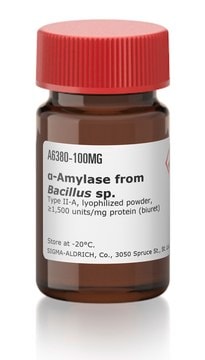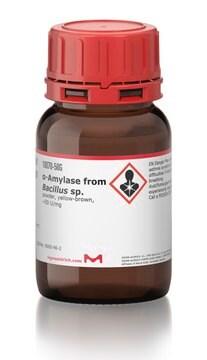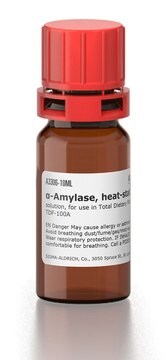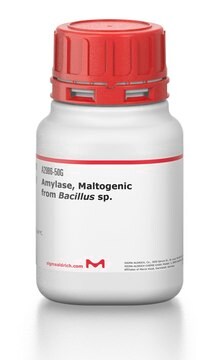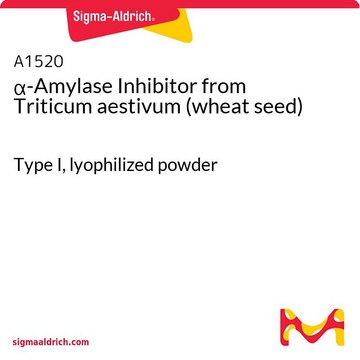A6814
α-Amylase from Bacillus sp.
powder, ≥400 units/mg protein (Lowry)
Synonym(s):
1,4-α-D-Glucan-glucanohydrolase
Sign Into View Organizational & Contract Pricing
All Photos(3)
About This Item
Recommended Products
biological source
Bacillus sp.
Quality Level
form
powder
specific activity
≥400 units/mg protein (Lowry)
mol wt
58-62 kDa
solubility
H2O: soluble 1.0 mg/mL
storage temp.
−20°C
Looking for similar products? Visit Product Comparison Guide
Application
α-Amylase is used to hydrolyze α bonds of α-linked polysaccharides, such as starch and glycogen. α-Amylase, from Sigma, has been used in various plant studies, such as metabolism studies in Arabidopsis . α-has also been also used to study the ability of corn and starch to protect enzyme activity. The enzyme has been used to compare the effects of bacterial and fungal α-amylase and scalded flour on bread quality and shelflife. It has also been used to determine the optimal levels of these components in order to achieve maximum volume and bread freshness. Furthermore, it has been used to digest hydroxypropylated starch in Korean waxy rice cake to retard retrogradation.
Biochem/physiol Actions
α-Amylase hydrolyzes the α-(1,4) glucan linkages in polysaccharides of three or more α-(1,4) linked D-glucose units. Natural substrates such as starch and glycogen are broken down into glucose and maltose. α -amylase, isolated from Bacillus subtilis is a dimer and has a monomer molecular weight of 48.9 kDa. α-Amylase is a metalloprotein and contains atleast one mol of calcium ion. The presence of calcium ion increases the stability of the enzyme towards denaturation by heat, acid, or urea. The pH range for activity of this product is 5.0 to 7.5, with the optimum pH range being 6.0-7.0. This product is stable from pH 5.0 to 10.0. The optimum temperature range is 65-75 °C. The effective temperature range is up to 90 °C.
Quality
Contains starch as an extender.
Unit Definition
One unit will liberate 1.0 mg of maltose from starch in 3 min at pH 6.9 at 20 °C.
Other Notes
View more information on enzymes for complex carbohydrate analysis at www.sigma-aldrich.com/enzymeexplorer
substrate
Signal Word
Danger
Hazard Statements
Precautionary Statements
Hazard Classifications
Resp. Sens. 1
Storage Class Code
11 - Combustible Solids
WGK
WGK 1
Flash Point(F)
Not applicable
Flash Point(C)
Not applicable
Personal Protective Equipment
dust mask type N95 (US), Eyeshields, Gloves
Certificates of Analysis (COA)
Search for Certificates of Analysis (COA) by entering the products Lot/Batch Number. Lot and Batch Numbers can be found on a product’s label following the words ‘Lot’ or ‘Batch’.
Already Own This Product?
Find documentation for the products that you have recently purchased in the Document Library.
Customers Also Viewed
Utilization of Hydroxypropylated Waxy Rice and Corn Starches in Korean Waxy Rice Cake to Retard Retrogradation
Han J-A, et al.
Cereal Chem., 82(1), 88-92 (2005)
Sylwia Głazowska et al.
Journal of experimental botany, 70(21), 6461-6473 (2019-09-11)
Plants have evolved different strategies to utilize various forms of nitrogen (N) from the environment. While regulation of plant growth and development in response to application of inorganic N forms has been characterized, our knowledge about the effect on cell
Comparison of the effects of microbial α-amylases and scalded flour on bread quality
Hopek M, et al.
Acta Scientiarum Polonorum. Technologia Alimentaria, 5(1), 97-106 (2006)
Theoretical and Experimental Studies of the Effects of Heat, EDTA, and Enzyme Concentration on the Inactivation Rate of α-Amylase from Bacillus sp.
Lecker DN and Khan A
Biotechnol. Progress, 12(5), 713-717 (1996)
Usage of Enzyme Substrate to Protect the Activities of Cellulase, Protease and α-Amylase in Simulations of Monogastric Animal and Avian Sequential Total Tract Digestion
Wang HT and Hsu JT
Asian-Australasian Journal of Animal Sciences, 19(8), 1164-1173 (2006)
Our team of scientists has experience in all areas of research including Life Science, Material Science, Chemical Synthesis, Chromatography, Analytical and many others.
Contact Technical Service